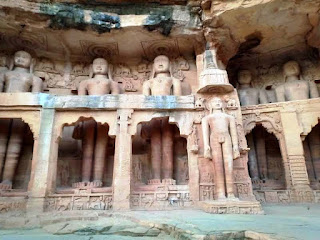India is a land of Gold mine for Archeologists and architects.. any region we travel, there are ballads and narratives found in every corner of the country. After various emperors who travelled and did their territory demarcation.. today the politically divided States as per the Sovereign Social Republic clearly reflect the culture and Unity in Diversity in various aspects, be it culture, space, region, food or architecture.
Madhya Pradesh, today being the centre of the country is a classic example where you can find historical structures, monuments and living spaces from across eras. Mughal, Marathas, Rajputs, Sikhs, Britishers etc.
Apart from this, there is a lot of correlation found in the architecture of structures found in other states which have been built in other eras.
 |
| Twin temples with elephant carvings as base |
 |
| Sas Bahu Temple Gwalior (vishnu temple) |
Sun Temple Modhera in Gujarat and Sas Bahu (as in pronounced) or Sahasra Bahu in Gwalior have a lot of similarities. Similar is the Temple in Gari Padawali near Gwalior.
 |
| Outside Base of Sun temple |
 |
| Sun Temple Modhera |
The stark architectural feature of the temple is the external base peripheral portion; which is usually made of elephants showing strength and weight carrying ability. This further rises with horses, Shakti and God carvings.
 |
| Gadi Padawali |
 |
| Mandapam in Padawali |
Sun Temple at Modhera was constructed in 11th Century by Chalukyas, The temple in Garhi Padawali which is dedicated to Lord Shiva was constructed in 10th Century AD, Sahasrabahu Temple was also constructed during the same period in 1093 AD by the Mahipala dynasty.
Inside of the mandapam (the temple hall), one can spot storyboards in form of stone carvings. The stories are from various Hindu scriptures which clearly narrate the tales of God's and Goddesses, their life, challenges, battles and the journey towards Nirvana. Ramayan, Mahabharata, Krishna's life, Shiva, Shakti and her forms, Kama Sutra etc. All three temples have major similarities, the only difference is the Garbhagriha, the main hall, where the deity is worshipped. The carvings change here as per the deity to whom the temple is dedicated.
Sun Temple has a water reservoir outside with steps and Sas Bahu temple has a Suraj Kund which is just 800 meters away.
Sun Temple has a water reservoir outside with steps and Sas Bahu temple has a Suraj Kund which is just 800 meters away.
Not only the above-mentioned structures have a parallel correlation.. but various other stone carvings found after excavation and destruction from around Gwalior which are showcased in an exhibition near the Gwalior fort too have a lot to say.. a lot in common we as humans had.. the difference was only attitude and approach probably. 24 forms of Vishnu, 24 Jain Tirthankaras
Gwalior fort, named after a saint Gwalipa, was built by Suraj Sen Pal in the 6th century. The royal residence was later captured and occupied by Mughals. The space in the fort which was once used to tie swings for queens of Rajputs was used for ropes only by Mughals, instead of swings where one could hear rejoice and laughter's, there were humans hanged.
 |
| Well where Johar was performed |
The well where queens used to have their Royal bath became a space of their funeral pyre where all the queens voluntarily gave up their life in Johar.
Going a little ahead, we also get to witness a gigantic marvel, Siddhanchal Jain cave temples, which were built between 7th to 15th century AD remind us of not only Mahabalipuram but Ajanta and Ellora caves also. The cave temples in Gwalior are dedicated to 24 Jain Tirthankaras, the tallest image of Adinath is 17.78 meter in height.
Sikh chivalry of Guru Har Gobind Singhji, in 1619, rescuing the 52 Kings from the bondage of Mughals in Gwalior, depicts the mantra of respecting individual preferences and unity in diversity. Gurudwara Data Bandi Chor near fort is still a standing example narrating the history from past. He made Jehangir realise his mistake and therefore he honoured Guruji, as he gave importance to humanity more by not just looking into his selfish interest..as his liberation came with the condition of releasing other kings held in captivity.
This example has been demonstrated by other Sikh Gurus eg Guru Teg Bahadur ji who got martyred, protecting the identity of Kashmiri Pandits and not allowing forceful conversion by Aurangzeb, defining true love for fellow beings through coexistence. Love isn't about letting others down, but helping and supporting until your existence is challenged.
Schindia’s today play a major role in carving the history of this region. Coming from Maratha clan, they have a living residence Jai Vilas Palace which reflects a shift in preferences, inspired by European architecture; Jai Vilas museum holds a bundle of vintage articles which the royal clan procured from various corners of the globe. They had friendly relations with the British leaders, thus hosted numerous royal guests from parts of Europe. Usha Kiran Palace was specially constructed for Prince of Wales.
One of the Navratna (nine gems of Akbars court) Tansen, earlier known as Ramtanu gathered his music knowledge from Gwalior and became a musician, composer and a vocalist. He spent his earlier life in court of Raja Ramchandra Singh, later at the age of 60 in 1562 he became a part of the Mughal court. His tomb also lies in silence today besides Mohammad Ghaus, Sufi master of Tansen.
Gwalior today is one such city in central India where cultures do cross, yet all alive.












Superb writeup and pics of our India..THANKS KULVEEN V NICE
ReplyDeleteMy pleasure always.. keep reading
Delete